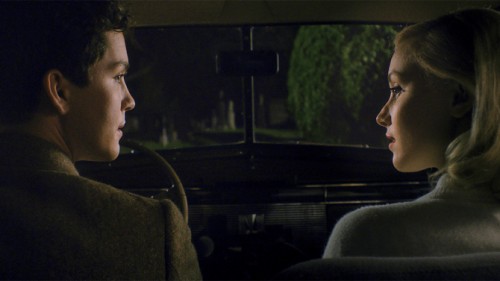Indignation: Under Glass, by David Bax
It would be simple to reduce James Schamus’ directorial debut, Indignation, to a “screenwriter’s movie.” This intelligent and classically-minded period piece is, after all, based on a novel by noted man of letters Philip Roth. To say such a thing, though, would be to ignore Schamus’ considerable formal efforts, which are at times so meticulous as to risk choking the air out of the film but are ultimately more rewarding than not.
Logan Lerman stars as Marcus Messner, the college-bound son of a Jewish butcher in 1951 Newark. With a number of Marcus’ cousins and friends having perished while fighting in Korea, his father begins to worry that Marcus going to Ohio to study will turn out to be a similar kind of loss. Those fears may not be as far-fetched as they sound when Marcus gets where he’s going and finds himself facing off against the school’s Christian dean (Tracy Letts) and falling in love with a troubled young woman (Sarah Gadon).
Indignation is the kind of movie that begs you to notice the production design and costumes. It’s not just that they’re beautiful; they’re also symbolically rich, with colors representing characters’ emotional states and futures, while a wallpaper pattern may be an emblem of a person’s entire past. Unlike Todd Haynes’ Carol, though, the stuff that fills the frame lacks tactility. Indignation is a film behind glass, appreciable with the eyes and the intellect but not in any visceral sense.
Schamus frames his tableaux straightforwardly, with little in the way of pushes or pans. He treats the actors the same way, occasionally centering their heads looking directly at the camera. It takes trust in performers to present them so baldly and, thankfully, Schamus’ trust is not misplaced. Lerman has been quietly impressive for years and Indignation is perhaps the first role truly worthy of his talents. Gadon transforms into the alternately brazen and vulnerable Olivia so much that I didn’t at first recognize her from Enemy or Belle. And Letts breaks free of the “Hey, it’s that guy” ranks with his turn as a man who is reasonable and compassionate (up to a point) but whom Marcus can only ever see as a villain. The film’s centerpiece scene, a sixteen and a half minute, one location back and forth between the two, is a daring move structurally that pays off because it becomes the fulcrum for the movie around it.
Marcus’ voiceover narration suggests from the beginning that what we’re watching is going to be a tragedy. It’s to the credit of all involved that (despite the film’s coldness) we often forget where it must be heading. We start to believe that things will work out for the best. That’s fitting since Indignation is ultimately a film about youthful hubris.






























